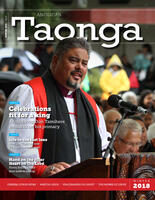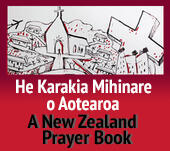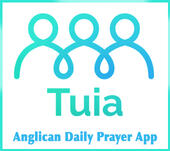The Diocese of Dunedin has expanded its calendar to commemorate twelve southern luminaries whose faithful witness has contributed to the story of faith in southern Aotearoa New Zealand, across Murihiku (Otago-Southland).
The newly installed commemorations in the Diocese of Dunedin calendar are as follows (Diocese of Dunedin Standing Resolutions 2023).
9 March
Arnold Spencer-Smith, priest. Antarctic explorer and padre, 1916
17 May
James Watkin, first missionary resident in the South Island, Waikouaiti, 1840
17 May
Johann Wohlers, first missionary resident in Southland, Ruapuke, 1844
18 May
Tamihana Te Rauparaha, Missionary to Te Wai Pounamu, 1876 be replaced with: Tāmihana Te Rauparaha and Mātene Te Whiwhi, missionaries to Te Wai Pounamu, 1843.
Colin McCahon, artist, 1987
29 June
Episcopal ordination and installation of Penny Jamieson, seventh Bishop of Dunedin, world’s first female diocesan bishop, 1990
2 July
Novicing of Bessie Te Wenerau Grace, Sister Eudora, first Māori female university graduate, religious, teacher, 1924.
8 August
Mary MacKillop, Teacher, 1909 in Diocese of Dunedin to be observed as: Mary MacKillop (Mary of the Cross), religious, teacher, arrived at Bluff 1897 with Josephite Sisters to teach in schools in Arrowtown and Port Chalmers.
11 August
Eviction of Hipa Te Maihāroa, prophet, and his community, Te Ao Mārama/Omarama, 1879
22 Sept
Diaconal ordination of Hoani Parata, 1907, first Kāi Tahu deacon and priest, first Māori member of General Synod
11 October
Rutherford Waddell, social reformer, Dunedin, 1888
1 December
The Sisters of the Church (founders of St. Hilda’s Collegiate and St. Margaret’s College) arrive in Dunedin, 1895
Notes
Arnold Spencer-Smith (1881-1916) was ordained priest at All Saints’ Episcopal Church Edinburgh before joining Shackleton’s Imperial Trans Antarctic Expedition. Spencer-Smith was the first priest to set foot on Antarctica, the first to celebrate the Eucharist there, and the first priest to die and be buried there. His chalice and paten were inherited by his cousin Philip Gaze, Vicar of All Saints’ Dunedin. His chalice and paten are in use at All Saints and he will be commemorated by a memorial window there.
James Watkin (1805-1886) Methodist missionary, first resident missionary in the South Island. Born in Manchester he served in Tonga and Australia before arriving at Waikouaiti in May 1840. He published the first book in Kāi Tahu dialect in 1842.
Johann Wohlers (1811– 1885) Lutheran missionary, first missionary resident in Southland. He left Germany for Nelson in 1842. In 1844 he was invited by Kāi Tahu chief Tūhawaiki to make his headquarters on Ruapuke Island, Foveaux Strait. He built a church there in 1846 and had a bell with "Ruapuki" cast on it sent out from Bremen by the North German Missionary Society. He lived for 41 years on the island. In 1900 the "Ruapuki" bell was installed at the bell tower of St Andrew's Anglican Church in Oban.
Colin McCahon (1919-1987) born in Timaru, he spent most of his childhood in Dunedin. He attended the Dunedin School of Art from 1937 to 1939. In 1942 he married fellow artist Anne Hamblett, daughter of William Hamblett, vicar of St. Matthew’s Dunedin. Christian faith is a constant theme throughout McCahon's art, his landscapes are imbued with a sense of the spiritual. McCahon often sets Biblical scenes in the Aotearoa New Zealand landscape.
Eviction of Hipa Te Maihāroa Te Maihāroa, was born at Te Waiateruati near Temuka, c.1800. In the 1857 census of Māori communities he is listed as an Anglican. Frustrated by injustice about land ownership, in June 1877 he led over 100 people on a heke/migration up the Waitaki valley to establish a new settlement called Te Ao Mārama (near Ōmārama). The land was cultivated, dwellings erected, and a large building constructed where Te Maihāroa held daily church services and established a school of learning. Local runholders viewed the occupation with suspicion and increasing alarm. An eviction order was issued, and a party of 12 armed constables was dispatched from Ōamaru. Together with local reinforcements they arrived at Te Ao Mārama on 11 August 1879 and gave the inhabitants 48 hours to leave. Due to Te Maiharoa’s words: ‘I do not want action which sheds blood’, a violent confrontation was narrowly averted. Consequently Te Maihāroa and his people began to make their way back down the river to the coast. Te Maihāroa established a new settlement at Korotuaheka, on the south bank of the Waitaki River near its mouth. Te Maihāroa died at Korotuaheka in 1885, and is buried there.
Hoani Parata (1881-1928) Kāti Huirapa Rūnaka ki Puketeraki, Te Aute College 1893-99, first Māori resident Selwyn College 1904-07. Deacon 1907, Priest 1908, Curate at: St. Paul’s Dunedin, Naples, Cartagena and Kennington. Vicar of Riverton, Chaplain to Māori Contingent 1917-19, Vicar of Gore, Canon of St Paul’s Dunedin, Vicar of Wakatipu, first Māori member of General Synod 1922-25. Parata Home in Gore, Parata scholars at Selwyn College and an annual lecture in Māori theology at the University of Otago are named in his honour.
Bessie Te Wenerau Grace, Sister Eudora CSC (1889-1944) was the first Māori female university graduate. Grace’s mother was the eldest daughter of the paramount chief of Ngāti Tūwharetoa.
Wene and her siblings lived in Blenheim with their Aunt and Uncle, Archdeacon and Mrs Grace. She enrolled at Canterbury University College in 1905. After teaching at St. Margaret’s College and St. Hilda’s Collegiate (1915-1922), she moved to London to join the Community of the Sisters of the Church. In London she completed her bachelor’s degree in 1926 and went on to graduate with a Master of Arts from the University of London. As Sister Eudora she became a teacher and school administrator, finishing her career as headmistress of St Michael’s Grammar School in Melbourne.
Tāmihana Te Rauparaha and Mātene Te Whiwhi Their mission work in Te Wai Pounamu (including Otago and Southland) took place in 1843. Te Rauparaha died in 1876, Te Whiwhi in 1881. (This updated entry corrects the omission of Te Whiwhi and amends the date of their missionary work).
Rutherford Waddell (1850?-1932) Irish-born Waddell was minister of St. Andrew’s Presbyterian Church in Dunedin for forty years. His 1888 sermon ‘The Sin of Cheapness’, launched the trade union movement in Aotearoa New Zealand. He was a founder of the Free Kindergarten Movement.
Mary MacKillop (St. Mary of the Cross) (1842-1909)
In the Calendar MacKillop founder of the Sisters of St Joseph of the Sacred Heart, is treated as someone without Aotearoa New Zealand connection, whereas she spent four periods in Aotearoa New Zealand between 1894 and 1902. She spent several months in Port Chalmers in 1898 establishing St Joseph's School. Mentioning Arrowtown and Port Chalmers connects her strongly with this place.
Sisters of the Church
Sisters Etheleen (1864-1942) and Geraldine (1861-1908) were the first of the Community of the Sisters of the Church to arrive in Aotearoa New Zealand in December 1895, other sisters followed. In 1896 the sisters opened St. Hilda’s Collegiate (first Anglican girls’ school in Aotearoa New Zealand and Polynesia) and in 1910 St. Margaret’s College in Christchurch. The sisters were recalled from Aotearoa New Zealand for other ministries in 1931.

















Comments
Log in or create a user account to comment.